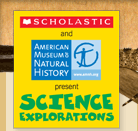Amniote (
am-nee-ote)
A vertebrate — such as a birds, other dinosaurs,
mammals, squamates, and turtles, whose life cycle includes
development in specialized embryonic membranes and sometimes
a hard shell .
Curator (kyoo-ray-tur)
The person in charge of a museum collection
Ectothermic (ek-to-thur-mic)
Ecto means outside and thermic means heat.
This is an adjective that describes organisms whose
body temperature is determined primarily by the environment.
An ectothermic animal may regulate its body temperature
by basking in the sun. Ectothermic animals are less
accurately referred to as "cold-blooded."
Herpetology (hur-pet-ol-uh-jee)
The study of reptiles and amphibians
Lizard (le-zerd)
A common name for certain limbed and limbless squamates
Reptiles (rep-tils)
A group that includes alligators, birds, crocodiles, squamates, tuataras, and turtles
Snakes (snak)
One group of mostly limbless squamates
Squamata (skwah-mat-a)
A group that includes snakes and lizards
Taxonomist (taks-on-oh-mist)
A specialist at classifying, ordering, and naming evolutionary
groups — like animals or plants — based
on their evolutionary relationships
Venom (ven-uhm)
Poison produced by many organisms. Venom is usually passed into a victim’s body through a bite or sting.







